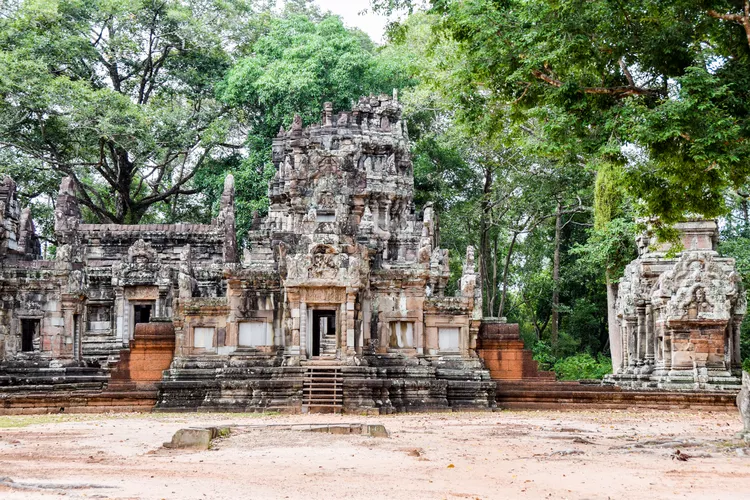Summary
Angkor Wat in Cambodia and the surrounding Khmer temples are one of the most spectacular archaeological sites in Asia — millions of tourists come to Siem Reap to visit the ancient remnants of a vast empire.
The Angkor Archaeological Park became a UNESCO World Heritage Site in 1992. New ruins are discovered frequently. In 2007, a team of archaeologists realized that Angkor, spread over at least 390 square miles, was the largest preindustrial city in the world at one time.
How you enjoy Angkor Wat in Cambodia is up to you. The main site, the easiest to access, is a bit of a tourist wonderland. However, scores of crumbling, unrestored temple ruins wait in the surrounding jungle.
Angkor Wat is considered the world’s largest religious monument. It appears in the center of the Cambodian flag.
Entrance Passes for Angkor Wat
Entrance passes are available in one-day, three-day, and seven-day varieties. Regardless of your itinerary, you won’t be able to gain a comprehensive understanding of the area in a single day; therefore, consider purchasing at least the three-day pass. A three-day pass costs less than two single-day passes.
Entrance fees to enter Angkor increased sharply in 2017; the price of a single-day pass nearly doubled. Unfortunately, despite Angkor Wat appearing on the Cambodian flag, not all revenue from ticket sales contributes to Cambodia’s infrastructure. A private company manages the site and retains a significant portion of the revenue.

Understand What You’re Seeing
Snapping photos in front of the many ancient ruins and bas-reliefs of Angkor Wat will keep you busy for a while, but you’ll have a much more enlightening experience if you actually understand what you’re seeing.
Knowledgeable guides can be hired for around US $20 per day, but beware of unauthorized freelance guides. If you hire a driver who doesn’t serve as a guide, always confirm where to meet them once you exit a temple. With hundreds of guides waiting in tuk-tuks that look similar, finding the one you hired can be tricky after exiting the labyrinth of temples!
If you prefer to go alone, grab one of the numerous maps or booklets that explain each site. The informative book Ancient Angkor is well worth the small cost; the history and insights will enhance your experience. Moreover, it is advisable to wait until you are near Angkor Wat to purchase the book; airport copies can be overpriced.
Avoiding Scams at Angkor Wat
Unfortunately, Angkor Wat, like many major tourist attractions, is rife with scams. Be wary of anyone approaching you inside the temples, particularly if there aren’t many visitors nearby at the time.
- Off-duty police officers in uniform sometimes approach tourists at temples offering information about a particular temple or asking for a bribe. Avoid interactions with them entirely.
- Official tuk-tuk and motorbike taxi drivers are required to wear colored vests. Avoid transportation from any driver not wearing an official vest.
- After purchasing an entrance pass, you will not need to pay any additional fees. Therefore, don’t believe anyone asking for extra money at temple entrances or for climbing stairs to top levels.
- Don’t allow monks or anyone else to hand you an incense stick, bracelet, or gift—they often ask for donations afterwards.
- Renting a bicycle or motorbike can be a great way to move around Siem Reap and between temple sites. Always lock your bike; theft is a concern.
- Although purchasing books, postcards, and bracelets from the persistent children seems like a way to help, it perpetuates a nefarious industry and isn’t a sustainable solution.
What to Wear While Visiting Angkor
Remember that Angkor Wat is the largest religious monument in the world; therefore, be respectful in the temples. The sight of numerous visitors praying is a reminder that the complex is more than just a tourist attraction. Dress modestly.
Cambodians typically adhere to a dress code of covering knees and shoulders while exploring Angkor Wat. Avoid skimpy clothing or attire featuring Hindu or Buddhist religious themes. You’ll appreciate dressing conservatively once you see the number of monks roaming the temples.
While flip-flops might be popular in Southeast Asia, many of the stairs to the top levels of temples are steep and dangerous. Take sturdy shoes if you plan to do any scrambling. A hat is also recommended to keep the sun off, although it should be removed in some areas as a sign of respect.
Must-See Angkor Wat Temples
Although there are thousands of Angkor temples dotted throughout Cambodia, some are particularly spectacular.
The most popular temples include:
- Angkor Wat (main site)
- Angkor Thom
- Preah Khan
- Banteay Srei
- Bayon
- Ta Prohm (the Tomb Raider temple)
- Bakong
Once you’ve thoroughly enjoyed the primary temple sites, consider visiting smaller, lesser-known sites. The main Angkor Wat complex is usually bustling with activity, particularly during the busy season from December to March. Yet, you may find smaller temples, which are difficult to reach, practically deserted—offering improved photo opportunities without the crowds.
Unless you are proficient with a scooter rental and map, you’ll need to hire a good guide/driver to reach some secondary temple sites. Inquire about the following:
- Ta Keo
- Neak Pean
- Thommanon
- Banteay Samre
- East Mebon
- Srah Srang
Getting to the Temples
Angkor is located just 20 minutes north of Siem Reap, Cambodia, with various options available for transport between the two locations.
The best time to visit Angkor Wat is during the dry season from November to April; however, heavy rainfall during the monsoon months can make exploring the ruins a soggy experience.
The busiest months at Angkor Wat are typically December, January, and February. March and April can be uncomfortably hot and humid.





